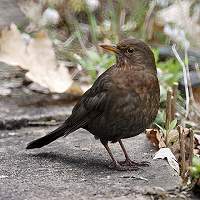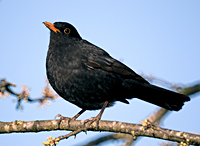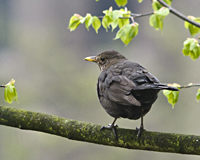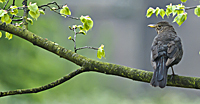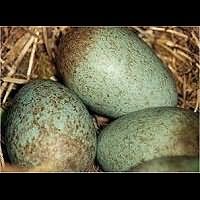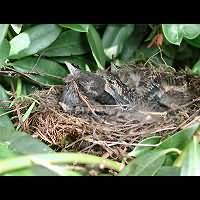[All pictures of garden wildlife on this page are thumbnails. Click on any thumbnail for a large format to be displayed.]
Blackbird (Turdus merula)
Click![]() here for the bird's sound.
here for the bird's sound.
Only the male Blackbird, to the right, is really black. The female, to the left, is a kind of brown.
As you can guess from the name, the blackbird is black! Bear in mind that the black colour applies to the male Blackbird as the female is brown. The Blackbird is the most common bird in Holland. It is estimated that there are some 2.8 million Blackbirds in my country nowadays! It means that the bird is now more common than the House Sparrow. It can be found in every park (even very small ones in the middle of the bigger cities), garden or forest, though it does not stay in larger meadows. About a hundred years ago Blackbird was considered to be very shy and living exclusively in forests where it could hide easily. In cause of time it succesfully adopted to another lifestyle and the habitat of moderm humans. Blackbird is very fond of insects but it also attracted to fruit, for instance, apples which you can see in the picture below. It shows a male feeding its chicks although one of them got tired of waiting to get its feeding turn and already started to feed itself. It is relatively easy to take pictures of a Blackbird, hence, several pictures in this page are over 20 years old. They were taken in the garden of my first house with my film camera Nikon FA and 50mm Nikkor lens. A pair of blackbirds built their nest just beside the garage door so apparently the birds didn't mind the presence of people. All kinds of noises and activities there with people walking in and out of the garage and even special attention of the photographer didn't seem to interfere with the Blackbirds' brooding and taking care of the chicks.
This female Blackbird sat close to my window and was posing gracefully before my camera.
This bird belongs to the family of Thrushes (Turdiidae). It is very common in my garden and can be easily spotted in Holland all year long. The bird is 10" and weighs 95 grams. Its habitat are woodlands, parks and gardens. It eats worms, insects, berries, fruit and seeds. Compared to the yellow beaked and black feathered male, the female is brown-black and has a brown beak. Blackbirds start making their nests already very early in spring, in some years as early as in February. Don't be surprised to notice young blackbirds hopping around by the end of March already. If the weather does not cooperate by getting too cold, the Blackbird simply starts a new nest later. Having young chicks very early has important advantages. First of all other birds do not have their chicks yet, which means that there is less competition for food. Secondly, there is a less chance that the predator birds will steal Blackbirds' eggs and young chicks. Just like most Thrushes the Blackbird produces four or five eggs. It breeds them for two weeks. It takes the chicks only 13 days to be able to leave the nest.
Left: The Blackbird's eggs are green and beautifully freckled. The chicks are less impressive to see due to their camouflaging colours and patterns.
| Name of this bird in various other languages | ||||
| Dutch | German | French | Polish | Scientific |
| Merel | Amsel | Merle noir | Kos | Turdus merula |

© Copyright 1998-2024 gardensafari.net (Hania Berdys)

 English / engels
English / engels  Dutch / nederlands
Dutch / nederlands